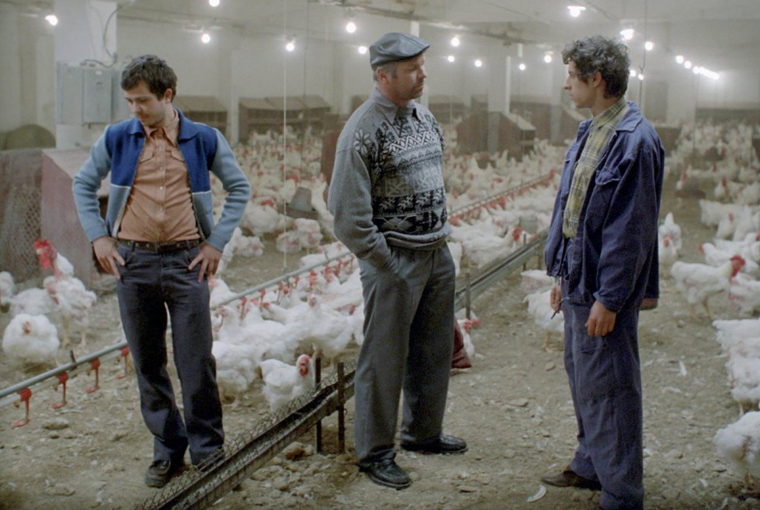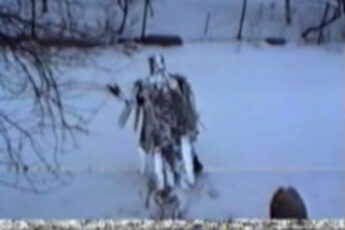Neighbors
Tales from the Golden Age: Absurdity at the Dusk of Ceausescu’s Era
Vol. 12 (December 2011) by Ana Ribeiro
Tales from the Golden Age (Amintiri din Epoca Aur, Romania, 2009), released in cinemas in 2009, is director Cristian Mungiu’s most recent project. It is a “project” in the most general sense of the term. A collective work, the film was originally divided into two segments, Dragoste in timpul liber (Love in free times) and Tovarasi, frumoasa e viata (Comrades, life is beautiful). The first contains the shorts The Legend of the Air Sellers, The Legend of the Chicken Driver, and Mungiu’s previously-released Turkey Girl (shown in theaters and available as DVD). The second contains The Legend of the Official Visit, The Legend of the Party Photographer, The Legend of the Zealous Activist and The Legend of the Greedy Policeman.
Mungiu, who was also the producer together with Oleg Mutu and Pascal Caucheteux, wrote the scripts for all of the shorts. The direction of the films, however (with the exception of Turkey Girl) is not specifically attributed to any of the filmmakers who participated in the creation of Tales: Hanno Hofer (also responsible for the soundtrack), Razvan Marculescu, Constantin Popescu and Ioana Uricaru, and of course Mungiu himself. This gives the impression that the authorship is intentionally rendered opaque. The shorts do not have one “auteur,” but belong to a collectivity organized by Mungiu. Only one short, Turkey Girl, that was produced in 2005, clearly lays claims to Mungiu’s authorship. It was the film at the origin of the whole project.
Both segments of the film are based on urban tales of the last years of communism in Romania, the artificial Golden Age of Ceausescu’s regime. The two segments of the project have different tones: a comic tone characterizes the second segment, Tovarasi, frumoasa e viata. The first short of this segment, The Legend of the Official Visit, shows an inspector from the Party that goes to a small town in order to supervise the arrangements made by the local government for an official visit of a foreign delegation. It’s an absurd operation: the reception of the inspector prepared by the mayor of the village mixes festivity, communist principles and protests, including a banner against a certain neutron bomb.
The mayor struggles to keep up with the demands of the inspector, the authority figure in the film, finally honoring him with a feast. While all the participants drunkenly celebrate, the phone rings and the official visit is canceled. Whereas the mayor’s reaction, aside from frustration, is also relief that the party is officially over, the inspector reacts conversely: using his authority once more by suggesting that everybody take a ride on the carousel of the village’s fair.
And when the inspector says “everybody”, it is “everybody”, so even those responsible for the attraction are circling on the ride. When the mayor starts choking, it becomes evident that there’s no one to stop the carousel and that authorities will continue spinning around helplessly until the carousel runs out of gas. Could this be a warning about the danger of blindly obliging official orders? A judgement of mindless festivity? Whatever the cause, here is a time when no one seems to hear cries for real needs, even urgent ones.
The second short story is The Legend of the Party Photographer, set in the offices of the official newspaper Scîntea, in the House of People, the megalomaniac palace built by Ceausescu in Bucharest in the 1980s. Here the exaggerated influence of the high-ranked Party members is shown via the domaine of the press, and more specifically via the photo-shop-like manipulation of the ruler’s figure in photographs. Ceausescu must be taller and have a hat on his head like the French president Giscard d’Estaing, who is next to him in the picture. The obsession to seemingly insignificant details leads to a major mistake: the last minute Ceausescu can be seen with one hat on his head and another in his hands, inadvertently making it clear that the picture was manipulated, just as the manipulation of the country’s image and reality at large was becoming clear in that era.
The third tale, The Legend of the Zealous Activist enriches the analysis of the discordance between the the Party directives and the real needs and mindset of the Romanian population. In this story, an activist feverishly decides to contribute to one of the goals of the government, which is to eradicate illiteracy in small villages. Once he arrives in one of these small towns, he has to deal with problems of another nature. The main problem there is electricity, the adults are ashamed of sharing school benches with children and the “official” knowledge is challenged by the people’s “life” knowledge. In an environment that sometimes resembles one of the Middle Ages, he is obliged to use the authorities, calling upon the aid of the police to coerce the adults into going to school. Finally, this “official” knowledge he brought ends up by betraying him, and he leaves the city after a comic “accident”.
The last story of the segment, The Legend of the Greedy Policeman shows how making up schemes to get what one wants became part of the Romanian daily life since a very early age. Two schoolboys, Mircea and Dorut, try to “buy” the appreciation of a school colleague with sandwiches. Mircea is particularly keen on these methods: in order to help Dorut at school, he demands something in exchange: parts of the pig Dorut’s family is getting for Christmas. However, Dorut’s father is prone to do everything he can, not to share a single part of the animal. The process of killing the pig is comic yet tense, ending up with an accident. Dorut’s greed is counterproductive for his own family.
The segment Dragoste in timpul liber is composed of two tales both in a more romantic tone. The short is set in a specifically Romanian context, illustrating the teenager Crina’s quest for money for a school trip, while her parents are more interesting in saving for their life-long (and very Romanian) dream to buy a Dacia, the national “Communist” car. During a night at a friend’s house, Crina meets Bughi. She recognizes him as the bureaucrat who has passed by her house earlier in the film, requesting a bottle with water to “make tests”. That night, as they watch Bonnie and Clyde thanks to a friend’s VCR (said to cost as much as a Dacia), they form a similar relationship, with a Romanian twist. He invites her to join his scheme: knocking door to door pretending to be government officers to collect bottles of water that they can later sell, making more money than in a “regular” job. Crina not only embraces the idea and participates, but continues well after she’s no longer in need of the money. Despite her enthusiasm, her naïvité ultimately causes them to get caught, but Bughi has a second secret : he’s the nephew of an important party member, and practically exempt from regulations on acts of petty criminal activity.
The second tale is The Legend of the Chicken Driver. Grigore, the Chicken driver, drives a truck loaded with chickens to the port city of Constanta as his job. A “model” worker who follows rules faithfully without question, his habit is to stop at a tavern near the road, run by the voluptuous Camelia. This time, during a spring-time lunch at Camelia’s, someone steals one of the wheels of the truck. Grigore is not only forced to spend the night at the tavern, but has, for the first time, to open the truck to give water to the chicken. To his surprise, they’ve laid eggs – rare and valued commodity at Easter-time at the tavern. Camelia suggests selling them, and, influenced by her charm, Grigore agrees. Their ethically ambiguous scheme (who do the eggs belong to anyway?) lands Grigore in jail – since even eggs laid in a truck are deemed to be the state’s property.
The “annex” film is Mungiu’s Turkey Girl (produced by Hanno Hofer). Here, a girl from the countryside has to learn the tricks of the big city in order to help her hospitalized mother. This tale mixes sweetness and absurdity. The girl has to learn how to bribe the doctors and guards with money and presents. One of the gifts is her pet turkey, to which she has taught some tricks. When her dear pet dies, she embarks on an adventure very specific to 1980s Romania: in an effort to alleviate her grief, she’s taken by a friend to see Ceausescu’s House of the People. There, she is led to believe that her turkey is not dead, but ran away and her visit terminates with a hallucination : Ceausescu’s palace appears transposed on an image of her dear turkey, performing the tricks she taught it.
The two segments of Tales from the Golden Age are strongly linked, despite different styles, by their exploration of urban legends. The light tone of the stories and their comedic aspect (even when it ends badly as in the case of the “Chicken Driver”) can easily be interpreted, superficially, as nostalgia, following the wave of films like the German Goodbye Lenin! After all, the Golden Age of Romanian communism is often portrayed with love and laughter. This first layer of interpretation, however, does not stand up to deeper analysis.
Absurdity is not only a means to entertain the public and capitalize on nostalgia, but also a metaphorical method to describe what life became in the last years of Ceausescu’s rule. If some aspects are presented with sweetness, like the feast in the Official Visit, the school in the Greedy Policeman, the countryside life in Turkey Girl and the Zealous Activist, innocence is not a trait of all the characters. If most of them are not essentially “evil” – even Bughi’s scheme in the Air Sellers retains some naiïveté – they know how to circumvent the obstacles of life (here, official rules) with a certain type of “creativity” that looks effortless. This is the case for Crina, Camelia, Grigore, Mircea and many others. In other situations, such as the mayor in the Official Visit, the photographers in the Party Photographer and even the Zealous Activist, individuals are victims of the government’s authority, which is taken to a level that is out of control.
Tales from the Golden Age differs enormously from Mungiu’s dense drama 4 Months, 3 Weeks, 2 Days, but it is nevertheless possible to detect obvious parallels: despite a difference in style and tone, they are both critiques of the absurdity of daily life in Romania at the end of Ceausescu’s regime.




Leave a Comment